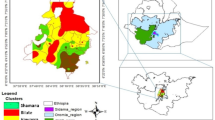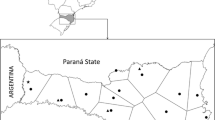Abstract
The implementation of two summer crops in the same growing season is a possible alternative for land intensification in areas with a long frost-free period. The aim of this study was to analyse the strategy of land intensification through the implementation of the maize-soybean succession at two locations (Reconquista, 29°09′S 59°40′W and Las Breñas, 27°05′S 61°5′W) of the humid subtropical region of Argentina. CERES-Maize and CROPGRO-Soybean models were used to evaluate the impact of inter-annual variability of climate (36 years) of both locations on rain-fed grain yields of the following productive alternatives: (i) monoculture of maize, (ii) monoculture of soybean and (iii) the succession of a short-cycle maize followed by soybean as the second summer crop (maize-soybean system). The maize-soybean system was evaluated by the method of land equivalent ratio (LER), based on the sum of the relative grain yields of its components. The impact of the inter-annual variability of climate and of “El Niño” or “La Niña” episodes (El Niño Southern Oscillation phenomenon (ENSO)) on LER values was analysed. Simulated yields of maize monoculture (5687 kg ha−1; CV = 49.7% and 5637 kg ha−1; CV = 57.6% at Reconquista and Las Breñas, respectively) were higher than those of the short-cycle maize, especially at Las Breñas (5448 kg ha−1; CV = 49.3% and 2322 kg ha−1; CV = 33.9% at Reconquista and Las Breñas, respectively). Simulated yields of the soybean monoculture were higher (3588 kg ha−1; CV = 26.1% and 2883 kg ha−1; CV = 20.7% at Reconquista and Las Breñas, respectively) that those of the soybean as the second crop (2634 kg ha−1; CV = 38.1% and 2456 kg ha−1; CV = 32.9% at Reconquista and Las Breñas, respectively) at both locations. Average LERs were 1.69 (CV = 11.4%) at Reconquista and 1.41 (CV = 26.1%) at Las Breñas, and the inter-annual variability of LER was mainly determined by grain yields of (i) soybean as the second crop at Reconquista and (ii) maize monoculture at Las Breñas. Soil water content after maize harvest and rainfalls during reproductive period of soybean as the second crop conditioned LER values, but they were generally greater than 1. At Reconquista, LER values were not affected by the different episodes of ENSO phenomenon. By contrast, at Las Breñas, LER values were higher during La Niña episodes (1.48; CV = 26.6%) than during El Niño episodes (1.32; CV = 23.7%) mainly by their effects on grain yields of maize monoculture. Therefore, crop simulation models demonstrate the possibility to intensify land use (40–70%) at two locations of the humid subtropical region of Argentina, by the implementation of the maize-soybean system.






Similar content being viewed by others
References
Andrade FH (1995) Analysis of growth and yield of maize, sunflower and soybean grown at Balcarce, Argentina. Field Crops Res 41:1–12
Andrade JF, Cerrudo AA, Rizzalli RH, Monzón JP (2012) Sunflower–soybean intercrop productivity under different water conditions and sowing managements. Agron J 104:1049–1055
Aramburu MF, Monzón JP, Mercau JL, Taboada M, Andrade FH, Hall AJ, Jobbagy E, Cassman KG, Grassini P (2015) Potential for crop production increase in Argentina through closure of existing yield gaps. Field Crops Res 184:145–154
Berry J, Bjorkman O (1980) Photosynthetic response and adaptation to temperature in higher plants. Annu Rev Plant Phys 31:491–543
Board JE, Tan Q (1995) Assimilatory capacity effects on soybean yield components and pod number. Crop Sci 35:846–851
Boote KJ, Jones JW, Pickering NP (1996) Potential uses and limitations of crop models. Agron J 88:704–716
Buringh P, Dudal R (1987) Agriculture land use in space and time. In: MG Wolman, FGA Fournier (eds.) land agriculture. John Willey and sons, New York, pp 9–45
Calderini DF, Maddoni GA, Miralles DJ, Ruiz RA, Satorre EH (1994) Validación del modelo CERES–wheat para producciones extensivas de trigo en diferentes situaciones de fertilidad del norte de la provincia de Buenos Aires. Proceedings of III Congreso Nacional de Trigo, pp 81–82
Calviño PA, Sadras V, Andrade FH (2003a) Development, growth and yield of late-sown soybean in the southern pampas. Europ J. Agronomy 19:265–275
Calviño PA, Sadras V, Andrade FH (2003b) Quantification of environmental and management effects on the yield of late-sown soybean. Field Crops Res 83:67–77
Capristo PR, Rizzalli RH, Andrade FH (2007) Ecophysiological yield components of maize hybrids with contrasting maturity. Agron J 99:1111–1118
Caviglia OP, Andrade FH (2010) Sustainable intensification of agriculture in the Argentinean pampas: capture and use efficiency environmental resources. Am J plant Sci. Biotech 3:1–8
Caviglia OP, Sadras VO, Andrade FH (2004) Intensification of agricultural in south-eastern pampas I. Capture and efficiency in the use of water and radiation in double-cropped wheat-soybean. Field Crops Res 87:117–129
Caviglia OP, Sadras VO, Andrade FH (2013) Modelling long-term effects of cropping intensification reveals increased water and radiation productivity in the south-eastern pampas. Field Crops Res 149:300–311
Coll L, Cerrudo AA, Rizzalli RH, Monzon JP, Andrade FH (2012) Capture and use of water and radiation in summer intercrops in the south-east pampas of Argentina. Field Crops Res 134:105–113
Commuri PD, Jones RJ (2001) High temperatures during endosperm cell division in maize: a genotypic comparison under in vitro and field conditions. Crop Sci 41:1122–1130
Connolly J, Goma HC, Rahim K (2001) The information content of indicators in intercropping research. Agric Ecosys Environ 87:191–207
De Fina AL, Ravelo AC (1979) Rocio-Heldas. In: De Fina AL, Ravelo AC (eds) Climatología y fenología agrícolas. Editorial Universitaria de Buenos Aires, Buenos Aires, pp 199–216
bosques D d (2007) Informe sobre deforestación en Argentina. In: 10 pp
Ernst O, Bianculli M (2013) Rendimiento, fenología y uso de agua en inter siembra trigo-soja con relación a cultivos secuenciales y cultivo de cobertura-soja. Agrociencia 17:33–44
FAO (2015) FAOSTAT. http://faostat3.fao.org
Fehr WR, Caviness CE (1977) Stages of soybean development. Iowa Agricultural Experimental Station Special Report 80
Fukai S (1993) Intercropping – bases of productivity. Field Crops Res 34:239–245
Giménez V (2015) Análisis probabilístico de la secuencia maíz/soja de tercera en una zona subtropical húmeda de la Argentina (NE de Santa Fe). Undergraduate thesis 42 pp
Hoogenboom G, White JW, Messina CD (2004) From genome to crop: integration through simulation modeling. Field Crops Res 90:145–163
Jones JW, Hoogenboom G, Porter C, Boote KJ, Batchelor WD, Hunt LA, Wilkens P, Singh U, Gijsman A, Ritchie JT (2003) The DSSAT cropping system model. Eur J Agron 18:235–265
Kiniry JR, Ritchie JT, Musser RL (1983) Dynamic nature of the photoperiod response in maize. Agron J 75:700–703
Maddonni GA (2012) Analysis of the climatic constraints to maize production in the current agricultural region of Argentina, a probabilistic approach. Theor Appl Climatol 107:325–345
Major DJ, Johnson DR, Tanner JW, Anderson IC (1975) Effects of daylength and temperature on soybean development. Crop Sci 15:174–179
Menéndez FJ, Satorre EH (2007) Evaluating wheat yield potential determination in the argentine pampas. Agric Syst 95:1–10
Mercau JL, Dardanelli JL, Collino DJ, Andriani JM, Irigoyen A, Satorre EH (2007) Predicting on-farm soybean yields in the pampas using CROPGRO-soybean. Field Crops Res 100:200–209
Mercau JL, Satorre EH, Otegui ME, Maddonni GA, Cárcova J, Ruiz RA, Uribelarrea MA, Menéndez FJ (2001) Evaluación a campo del comportamiento del modelo CERES en cultivos de maíz del norte de la provincia de Buenos Aires. Proceedings of VII Congreso Nacional de Maíz, Pergamino
Miranda WR, Andriulo A, Cirilo AG, Otegui ME (2012) Simulación del carbono orgánico del suelo: doble-cultivos vs. monocultivos. Proceedings of XIX Congreso Latinoamericano y XXIII Congreso Argentino de la Ciencia del Suelo (AACS), Mar del Plata, Argentina
Monzón JP, Mercau JL, Andrade JF, Caviglia OP, Cerrudo AG, Cirilo AG, Vega CRC, Andrade FH, Calviño PA (2014) Maize-soybean intensification alternatives for the pampas. Field Crops Res 162:48–59
Muchow RC, Sinclair TR, Bennett M (1990) Temperature and solar radiation effects on potential maize yield across locations. Agron J 82:338–343
Norse DC, James C, Skinner BJ, Zhao Q (1992) Agriculture, land use and degradation. In: Doodge JCI, Goodman GT, Riviére JWM, Marton-Lefévre J, O’Riordan T, Praderie F (eds) an agenda of science for environment and development into the 21st century. Cambridge University Press, London
Otegui ME, Bonhomme R (1998) Grain yield components in maize I. Ear growth and kernel set. Field Crops Res 56:247–256
Rattalino Edreira JI, Budakli Carpici B, Sammarro D, Otegui ME (2011) Heat stress effects around flowering on kernel set of temperate and tropical maize hybrids. Field Crops Res 123:62–73
Ray DK, Muller ND, West PC, Foley JA (2013) Yields trends are insufficient to double global crop production by 2050. PLoS One 8:e66428. https://doi.org/10.1371/journal.pone.0066428
Ritchie SW, Hanway JJ, Benson, GO (1993) How a corn plant develops. Special Report 48. Iowa State University
Rusell WA (1986) Contribution of breeding to maize improvement in the United States, 1920s-1980s. Iowa State J Res 61:5–34
Sadler EJ, Gerwig BK, Evans DE, Millen DE, Bauer PJ, Busscher WJ (1999) Site-specificity of CERES-Maize model parameters: a case of study in southeastern US coastal plain. In: 2nd European conference on precision agriculture. Denmark, Odense
Silvertown JM (1982) Introduction to plant population ecology. Longman, London
Soil survey staff (2010) Keys to soil taxonomy, 11th edn. USDA-Natural Resources Conservation Service, Washington
Tilman D, Balzer C, Hill J, Befort BL (2011) Global food demand and the sustainable intensification of agriculture. https://doi.org/10.1073/pnas.1116437108
Tollenar M, Dwyer LM, Stewart DW (1992) Ear and kernel formation in maize hybrids representing three decades of grain yield improvement in Ontario. Crop Sci 32:434–438
Vandermeer JH (1989) The ecology of intercropping. Cambridge University Press, New York, p 237
Acknowledgements
The author wishes to thank N Ciancio, S Incógnito, J Fuentes and M Rodríguez for the technical assistantship. Gustavo Maddonni is a researcher of the National Council of Scientific and Technical Research (CONICET). Victor David Giménez held a grant of CONICET. This work was partially funded by Syngenta Argentina S.A.
Author information
Authors and Affiliations
Corresponding author
Rights and permissions
About this article
Cite this article
Giménez, V.D., Micheloud, J.R. & Maddonni, G.Á. Climatic constraints for the maize-soybean system in the humid subtropical region of Argentina. Theor Appl Climatol 134, 753–767 (2018). https://doi.org/10.1007/s00704-017-2302-7
Received:
Accepted:
Published:
Issue Date:
DOI: https://doi.org/10.1007/s00704-017-2302-7




